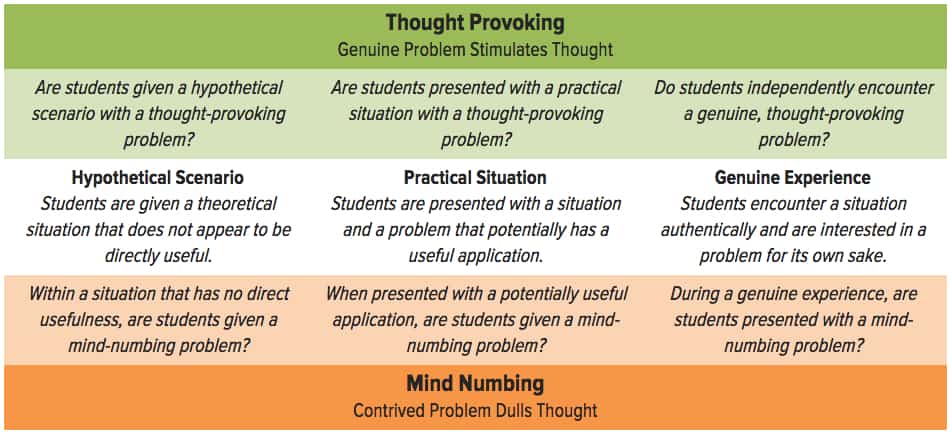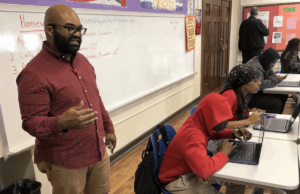Forget “Academics” For Middle School. Focus On Engagement and Authenticity

This blog first appeared on dreambox.com.
Tim Hudson
Several years ago when my school district was working to create a new, more actionable mission statement, we hit an unforeseen bump in the road. We were proudly reviewing our sixth draft of the statement (which was 95 percent finished) when we received the feedback from an anonymous community member that our mission made no reference to “academics.” Their question was, “How can a school district’s mission not include any mention of academics?”
What “academics” means. We quickly consulted a dictionary to see how well the term “academic” connected to the core outcomes we had already outlined in our mission statement. It’s fair to say that none of the 40 members of the committee knew the extent of the true definition, because the descriptions we found were surprising:
- “theoretical or hypothetical; not practical, realistic, or directly useful”
- “learned or scholarly but lacking in worldliness, common sense, or practicality”
All of our conversations with the community and within the committee had centered on the need for students to be engaged and challenged with relevant material in all of their classes so that they could become better equipped to understand the world and use that understanding to confront meaningful challenges both individually and with others. Therefore, we confirmed our decision to leave the term “academic” out of the mission statement and included an explanation of our rationale in the FAQs that accompanied the mission statement:
As adults looking back, we know that some of our classes and courses were of little or no use, and we may have felt at times that we were simply jumping through hoops. It becomes critical that our mission and district practices avoid these pitfalls of traditional “academics” because, by definition, such practices will be the cause of boredom for all but a few students who are interested in those areas.
Authenticity nurtures the middle school mind. Relevance and engagement are essential for all learners, but perhaps they are most critical for young adolescents, who need to cultivate their curiosity and grow their love for learning. The Association for Middle Level Education (AMLE) points out several developmental characteristics of middle school students, including important aspects of their intellectual development. In particular, AMLE notes this key point:
During early adolescence, youth are more interested in real life experiences and authentic learning opportunities; they are less interested in traditional academic subjects. (Emphasis mine.)
Given the definitions of the term “academic” as listed above, it shouldn’t be any surprise that middle school students are often disengaged by classes where they are taught subjects that are impractical and lacking in common sense. As such, placing an emphasis on “more academics” is likely the wrong approach to improving achievement and student engagement for young adolescents.
Relevance and engagement are personal. One key to reaching all middle school students in mathematics is to find what truly engages them. This task is by no means quick and simple, but it’s also not one that is overwhelmingly impossible. Too often we’re pressed for time both when planning and implementing lessons, and we therefore overgeneralize about what we believe interests students. For example, when teaching topics in statistics, it’s tempting to think, “Baseball is a relevant real-world context for talking about statistics, so my students are sure to get excited about it.” However, it’s unlikely that every student in a classroom would be interested in baseball and its statistics.
Authenticity and/or practicality? It’s also critical to note that authenticity and practicality aren’t synonymous. For example, many middle school students enjoy playing video games that might not have any real-world applications (such as Super Mario World) or reflect practical situations (such as Angry Birds). But the tasks they perform in these games are authentic within the game world, the situations are practical in the game context, and the overall experience is fun and rewarding.
Therefore, when looking for digital math learning tools that support all middle school students, teachers should consider the level of authenticity that students experience in the digital environment. For example, middle school students would likely say that video lectures and digitized worksheets lack authenticity and could be described as impractical “academic” work. Thus, educators must critically evaluate well how software programs, math apps, and learning games engage students in mathematically meaningful experiences that are aligned with rigorous learning outcomes.
Be thought provoking. One guiding principle for engagement, relevance, and authenticity that I’ve used when designing classroom lessons and math games comes from John Dewey nearly a century ago in his book, Democracy and Education:
“first … the pupil [must] have a genuine situation of experience—that there be a continuous activity in which he is interested for its own sake; secondly, that a genuine problem develop within this situation as a stimulus to thought …”
Video games such as Angry Birds are an activity that students are interested in for their own sake (and often play continuously). According to Dewey’s principle, even though students won’t really learn subject matter content from the games, students experience these games in an authentic way precisely because games present situations that stimulate thought.
Be genuine. There are countless practical and mathematical situations for middle school students to experience in which they are stimulated to think critically. Some are certainly better than others, and they won’t all be “practical,” but when reflecting on the quality of a particular lesson, try using this matrix to classify how the lesson engages students. In general, when the situation in the lesson stimulates students to think about a genuine problem or situation—the top half of the matrix—lessons are more powerful and math is more enjoyable.
Engagement with purpose. Whether it’s a classroom-based lesson in which students are inspired to present viable arguments to the class and critique the reasoning of their classmates, or a differentiated digital experience with innovative virtual manipulatives, we must ensure that middle school students are able to engage with purpose in learning experiences that stimulate thought and result in deeper understanding and improved achievement.
For more information on middle school math, check out:
Learn how DreamBox® Learning, Getting Smart Advocacy Partner, generates math participation with purpose for middle school students and their teachers at DreamBox.com/middle-school.
For more about best practices, download the white paper, Nurturing the Middle School Mathematical Mind: Strategies for Teaching Middle School Math, and the related infographic—and feel free to share them.

Tim Hudson is Senior Director of Curriculum Design at DreamBox Learning. Follow Tim on Twitter at @DocHudsonMath.








Angela
Anti-intellectualism is alive and well.The Oxford English Dictionary also defines academic as "Reading, thinking, and study as opposed to technical or practical work;" "Of, relating to, or characteristic of an educational institution or environment; concerned with the pursuit of research, education, and scholarship; scholarly, educational, intellectual.>" Why can't teaching involve both the practical side and the theoretical side? I have seen good teachers make scholarly topics engaging and authentic, and provide connections to these topics to the student's world.